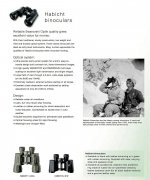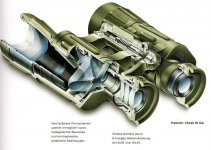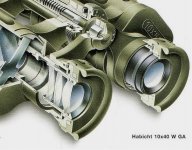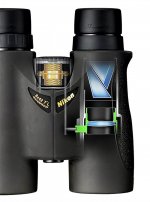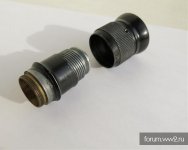In terms of the feel of the focuser, the non-airtight version of the Habicht (from 1948 to 1984) has a feel similar to that of many other external focus binoculars
e.g. as with my 1962 model
The 1984 airtight (and nitrogen filled) upgrade to the Habicht is immediately recognisable by the addition of the screws on the front bridge arms that cover the valve ports
It was made airtight by the expedient of fitting a rubber seal for each eyepiece assembly to move through when focusing
(for a detailed history of the various changes to the Habicht line, see the first table at:
https://www.birdforum.net/showpost.php?p=3974081&postcount=6 )
Clay Taylor of SONA states that there are ‘ . . . double-waterproofing seals on the bridge.’ see post #12 at:
https://www.birdforum.net/showthread.php?t=102060
While this is somewhat unclear, from the closeup of the attached image there appears to be 1 seal per eyepiece assembly
i.e. the ring that’s recessed into the end of the tube into which the eyepiece assembly fits
Interestingly, my rubber armoured 8x30W from late 1999 has a
much lighter focus action then my three more recent models from 2013 to 2017
It’s action is akin to that of my Nikon 8x30 EII - so perfectly acceptable for uses such as birding
And of further interest, Tobias Mennle notes in the review of his 2009 production 8x30W that ’I was not happy with the focusing,
but the Swarovski service fixed it perfectly and it is now a real joy to use. A bit more friction than the SE, especially on cold days.’
see around half way down the page under ‘Cons/ Stiff focus’ at:
http://www.greatestbinoculars.com/a...vski/swarohabicht8x30w/swarohabicht8x30w.html
So it seems there is a way for the factory to adjust the degree of focuser effort (though perhaps with some compromise as to the degree of airtightness?)
- - - -
It's a tribute to Swarovski sense of heritage and continuity that they offer two lines of legacy items
Along with the Habicht binoculars, Swarovski also offers two draw tube telescopes: the fixed lens CTC 30x75; and the interchangeable lens CTS 85;
see the details at:
https://aa.swarovskioptik.com/birding/ctc-cts-c210203
Both lines are dated but proven designs that use quality materials (especially including up-to-date coatings) and are produced to Swarovski’s usual high quality standards
Significantly they are not priced artificially high, so as to technically be available but so overpriced as to be effectively discontinued
And within their limitations both lines represent great value, especially when taking into account Swarovski’s generous after-sales service
John





